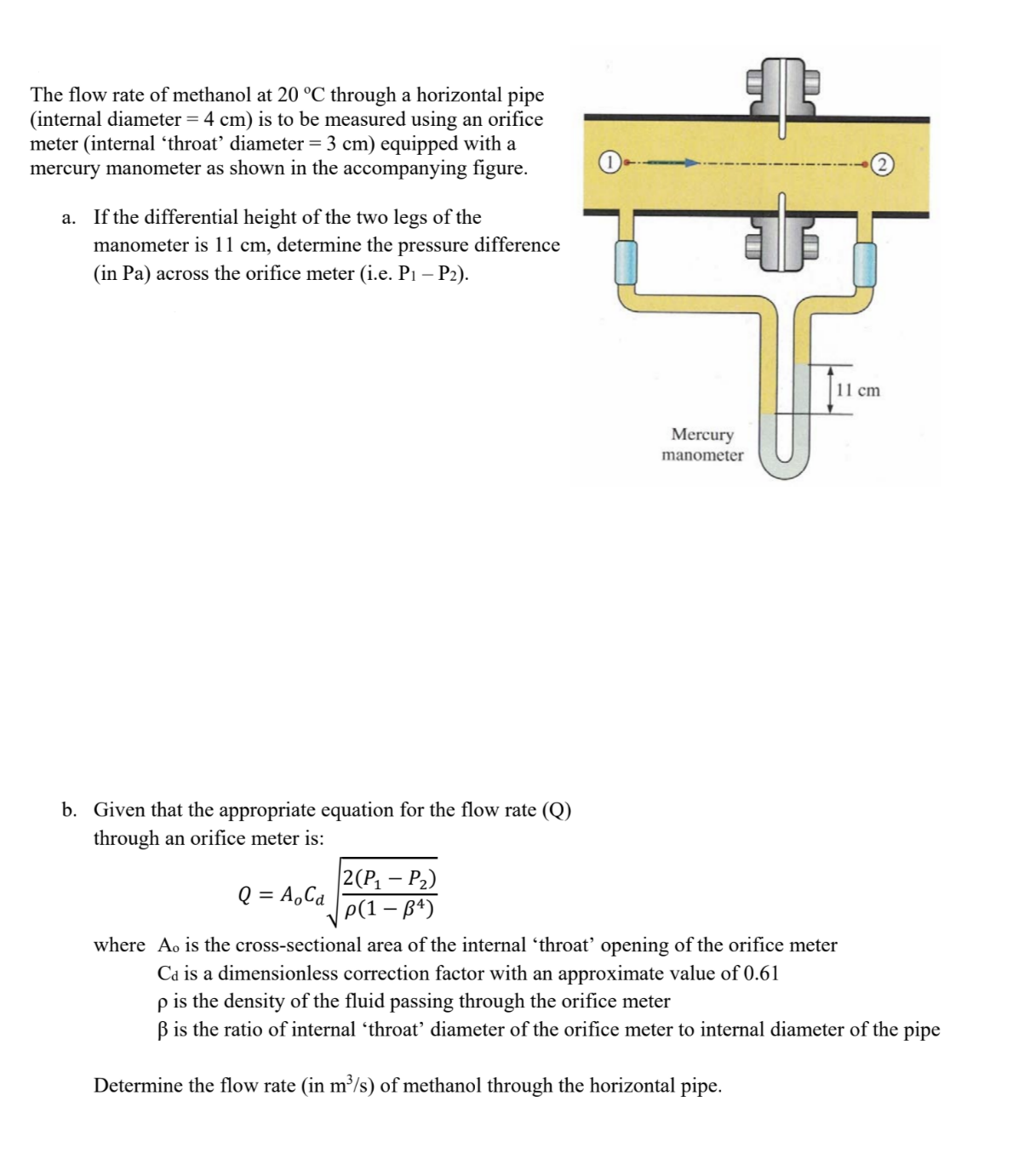The flow rate of methanol at 20 °C through a horizontal pipe (internal diameter = 4 cm) is to be measured using an orifice meter (internal 'throat' diameter = 3 cm) equipped with a mercury manometer as shown in the accompanying figure. a. If the differential height of the two legs of the manometer is 11 cm, determine the pressure difference (in Pa) across the orifice meter (i.e. P₁ - P₂). b. Given that the appropriate equation for the flow rate (Q) through an orifice meter is: 2(P₁-P₂) p(1-B4) E1₂ €16 Mercury manometer 11 cm Q = A₂Cd where Ao is the cross-sectional area of the internal 'throat' opening of the orifice meter Ca is a dimensionless correction factor with an approximate value of 0.61 p is the density of the fluid passing through the orifice meter ß is the ratio of internal 'throat' diameter of the orifice meter to internal diameter of the pipe Determine the flow rate (in m³/s) of methanol through the horizontal pipe.
The flow rate of methanol at 20 °C through a horizontal pipe (internal diameter = 4 cm) is to be measured using an orifice meter (internal 'throat' diameter = 3 cm) equipped with a mercury manometer as shown in the accompanying figure. a. If the differential height of the two legs of the manometer is 11 cm, determine the pressure difference (in Pa) across the orifice meter (i.e. P₁ - P₂). b. Given that the appropriate equation for the flow rate (Q) through an orifice meter is: 2(P₁-P₂) p(1-B4) E1₂ €16 Mercury manometer 11 cm Q = A₂Cd where Ao is the cross-sectional area of the internal 'throat' opening of the orifice meter Ca is a dimensionless correction factor with an approximate value of 0.61 p is the density of the fluid passing through the orifice meter ß is the ratio of internal 'throat' diameter of the orifice meter to internal diameter of the pipe Determine the flow rate (in m³/s) of methanol through the horizontal pipe.
Introduction to Chemical Engineering Thermodynamics
8th Edition
ISBN:9781259696527
Author:J.M. Smith Termodinamica en ingenieria quimica, Hendrick C Van Ness, Michael Abbott, Mark Swihart
Publisher:J.M. Smith Termodinamica en ingenieria quimica, Hendrick C Van Ness, Michael Abbott, Mark Swihart
Chapter1: Introduction
Section: Chapter Questions
Problem 1.1P
Related questions
Question

Transcribed Image Text:The flow rate of methanol at 20 °C through a horizontal pipe
(internal diameter = 4 cm) is to be measured using an orifice
meter (internal 'throat' diameter = 3 cm) equipped with a
mercury manometer as shown in the accompanying figure.
a. If the differential height of the two legs of the
manometer is 11 cm, determine the pressure difference
(in Pa) across the orifice meter (i.e. P₁ – P₂).
b. Given that the appropriate equation for the flow rate (Q)
through an orifice meter is:
2(P₁-P₂)
p(1-B4)
퇴보
F
11 cm
Mercury
manometer
Q = A₂Ca
where Ao is the cross-sectional area of the internal 'throat' opening of the orifice meter
Ca is a dimensionless correction factor with an approximate value of 0.61
p is the density of the fluid passing through the orifice meter
ß is the ratio of internal ‘throat' diameter of the orifice meter to internal diameter of the pipe
Determine the flow rate (in m³/s) of methanol through the horizontal pipe.
Expert Solution
This question has been solved!
Explore an expertly crafted, step-by-step solution for a thorough understanding of key concepts.
This is a popular solution!
Trending now
This is a popular solution!
Step by step
Solved in 4 steps

Recommended textbooks for you

Introduction to Chemical Engineering Thermodynami…
Chemical Engineering
ISBN:
9781259696527
Author:
J.M. Smith Termodinamica en ingenieria quimica, Hendrick C Van Ness, Michael Abbott, Mark Swihart
Publisher:
McGraw-Hill Education

Elementary Principles of Chemical Processes, Bind…
Chemical Engineering
ISBN:
9781118431221
Author:
Richard M. Felder, Ronald W. Rousseau, Lisa G. Bullard
Publisher:
WILEY

Elements of Chemical Reaction Engineering (5th Ed…
Chemical Engineering
ISBN:
9780133887518
Author:
H. Scott Fogler
Publisher:
Prentice Hall

Introduction to Chemical Engineering Thermodynami…
Chemical Engineering
ISBN:
9781259696527
Author:
J.M. Smith Termodinamica en ingenieria quimica, Hendrick C Van Ness, Michael Abbott, Mark Swihart
Publisher:
McGraw-Hill Education

Elementary Principles of Chemical Processes, Bind…
Chemical Engineering
ISBN:
9781118431221
Author:
Richard M. Felder, Ronald W. Rousseau, Lisa G. Bullard
Publisher:
WILEY

Elements of Chemical Reaction Engineering (5th Ed…
Chemical Engineering
ISBN:
9780133887518
Author:
H. Scott Fogler
Publisher:
Prentice Hall


Industrial Plastics: Theory and Applications
Chemical Engineering
ISBN:
9781285061238
Author:
Lokensgard, Erik
Publisher:
Delmar Cengage Learning

Unit Operations of Chemical Engineering
Chemical Engineering
ISBN:
9780072848236
Author:
Warren McCabe, Julian C. Smith, Peter Harriott
Publisher:
McGraw-Hill Companies, The